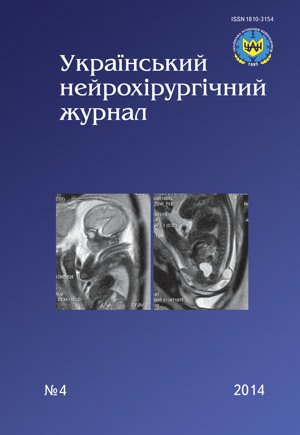Pathomorphological and immunohistochemical characteristics of vascularisation in benign and malignant meningiomas of the brain
DOI:
https://doi.org/10.25305/unj.46605Keywords:
meningioma, angiogenesis, vascular endothelial growth factor, vascular endothelial growth factor receptor-1Abstract
Aim. To determine the expression level of angiogenesis markers VEGF and VEGFR-1 in different histological subtypes of benign and in anaplastic meningiomas.
Materials and methods. 32 cases of meningiomas which were removed during neurosurgical operations were analyzed. We studied peculiarities of the expression of angiogenesis markers in benign and malignant brain meningiomas.
Results. VEGF expression was observed in tumor cells as well as in endothelial cells in 38, 8% of all cases. Tumors with weak, focal expression and also with immunonegative areas comprised 22, 2% of investigated cases. Expression of VEGFR-1 in microvessel endothelial cells was present in 61, 1% of analysed cases.
Conclusions.: 1. The expression level of VEGF significantly differs among various subtypes of benign meningiomas with the most intensive expression in transitional subtypes.
2. Fibroblastic subtypes of benign meningiomas are characterized by the least expression level of VEGF and VEGFR-1.
3. The relationship between the grade of meningiomas according to the WHO classification (2007) and the expression level of VEGF was not determined. Thus, the angiogenic potential depends upon the histological structure and does not depend on the degree of malignancy.
4. The expression level of VEGFR-1 doesn’t significantly differ between benign and anaplastic meningiomas.
References
Sherwood L, Parris E, Folkman J. Tumor Angiogenesis: Therapeutic Implications. New England Journal of Medicine. 1971;285(21):1182-1186. CrossRef
Fang S, Salven P. Stem cells in tumor angiogenesis. Journal of Molecular and Cellular Cardiology. 2011;50(2):290-295. CrossRef
Pradeep C. Expression of Vascular Endothelial Growth Factor (VEGF) and VEGF Receptors in Tumor Angiogenesis and Malignancies. Integrative Cancer Therapies. 2005;4(4):315-321. CrossRef
Schenone S, Bondavalli F, Botta M. Antiangiogenic Agents: an Update on Small Molecule VEGFR Inhibitors. Current Medicinal Chemistry. 2007;14(23):2495-2516. CrossRef
Nassehi D. Intracranial meningiomas, the VEGF-A pathway, and peritumoral brain oedema. Dan Med J. 2013;60(4):4626. PubMed
Erovic B, Neuchrist C, Berger U, El-Rabadi K, Burian M. Quantitation of microvessel density in squamous cell carcinoma of the head and neck by computer-aided image analysis. Wiener klinische Wochenschrift. 2005;117(1-2):53-57. CrossRef
Barresi V. Angiogenesis in meningiomas. Brain Tumor Pathology. 2011;28(2):99-106. CrossRef
Ferrara N, Gerber H, LeCouter J. The biology of VEGF and its receptors. Nat Med. 2003;9(6):669-676. CrossRef
Barresi V, Tuccari G. Increased ratio of vascular endothelial growth factor to semaphorin3A is a negative prognostic factor in human meningiomas. Neuropathology. 2010. CrossRef
Preusser M, Hassler M, Birner P et al. Microvascularization and expression of VEGF and its receptors in recurring meningiomas: pathobiological data in favor of anti-angiogenic therapy approaches. NP. 2012;31(09):352-360. CrossRef
Verma S, Dharmalingam P, Roopesh Kumar V. Vascular endothelial growth factor expression and angiogenesis in various grades and subtypes of meningioma. Indian J Pathol Microbiol. 2013;56(4):349. CrossRef
Pfister C, Pfrommer H, Tatagiba M, Roser F. Vascular endothelial growth factor signals through platelet-derived growth factor receptor β in meningiomas in vitro. British Journal of Cancer. 2012;107(10):1702-1713. CrossRef
Baumgarten P1, Brokinkel B, Zinke J, Zachskorn C, Ebel H, Albert FK, Stummer W, Plate KH, Harter PN, Hasselblatt M, Mittelbronn M. Expression of vascular endothelial growth factor (VEGF) and its receptors VEGFR1 and VEGFR2 in primary and recurrent WHO grade III meningiomas. Histol. Histopathol. 2013;28(9):1157-1166. PubMed
Lamszus K, Lengler U, Schmidt N, Stavrou D, Ergün S, Westphal M. Vascular Endothelial Growth Factor, Hepatocyte Growth Factor/Scatter Factor, Basic Fibroblast Growth Factor, and Placenta Growth Factor in Human Meningiomas and Their Relation to Angiogenesis and Malignancy. Neurosurgery. 2000;46(4):938-948. CrossRef
Otsuka S, Tamiya T, Ono Y et al. The relationship between peritumoral brain edema and the expression of vascular endothelial growth factor and its receptors in intracranial meningiomas. Journal of Neuro-Oncology. 2004;70(3):349-357. CrossRef
Louis D, Ohgaki H, Wiestler O, Cavenee W. World Health Organization Classification of Tumours of the Central Nervous System. Louis D, editor. Lyon:IARC; 2007.
Raica M, Cimpean A, Anghel A. Immunohistochemical expression of vascular endothelial growth factor (VEGF) does not correlate with microvessel density in renal cell carcinoma. Neoplasma. 2007;54:278-284.
Ferreira T, Rasband WS. ImageJ User Guide. IJ 1.46r [Internet]. 2010—2012. Available at: http://imagej.nih.gov/ij/docs/guide/
Downloads
Published
How to Cite
Issue
Section
License
Copyright (c) 2014 Wanda Voteva

This work is licensed under a Creative Commons Attribution 4.0 International License.
Ukrainian Neurosurgical Journal abides by the CREATIVE COMMONS copyright rights and permissions for open access journals.
Authors, who are published in this Journal, agree to the following conditions:
1. The authors reserve the right to authorship of the work and pass the first publication right of this work to the Journal under the terms of Creative Commons Attribution License, which allows others to freely distribute the published research with the obligatory reference to the authors of the original work and the first publication of the work in this Journal.
2. The authors have the right to conclude separate supplement agreements that relate to non-exclusive work distribution in the form of which it has been published by the Journal (for example, to upload the work to the online storage of the Journal or publish it as part of a monograph), provided that the reference to the first publication of the work in this Journal is included.









